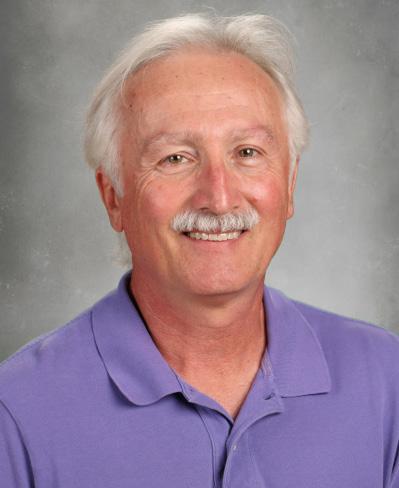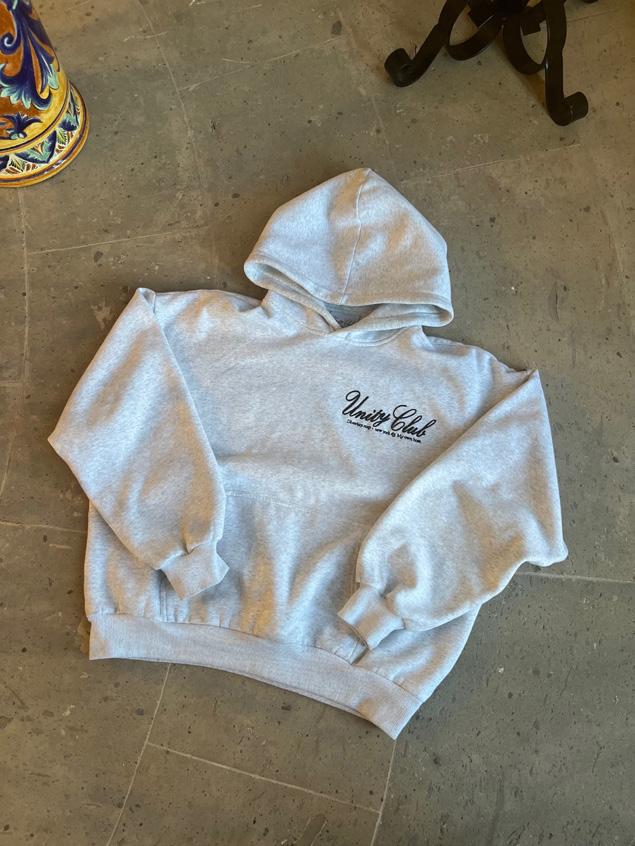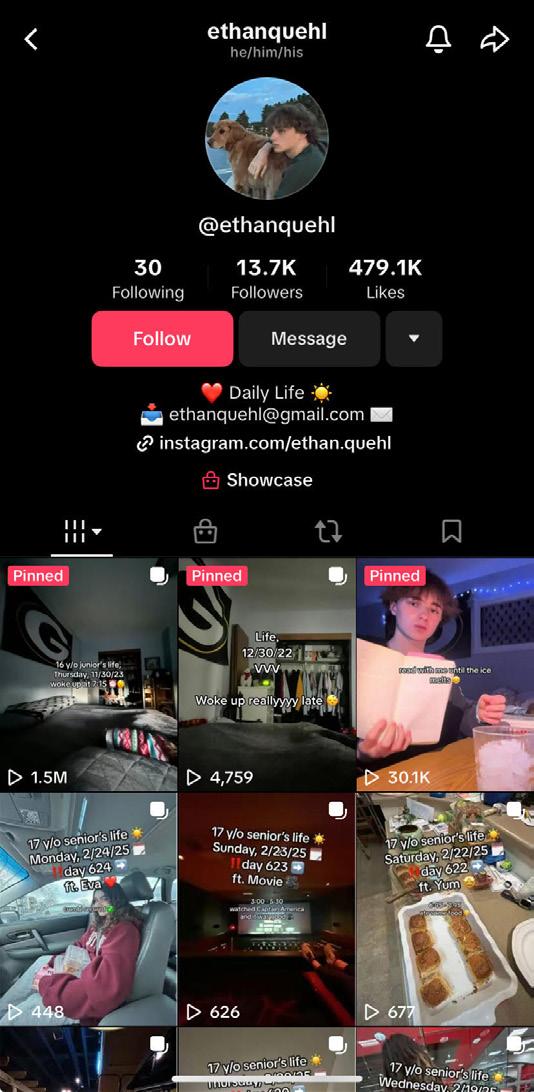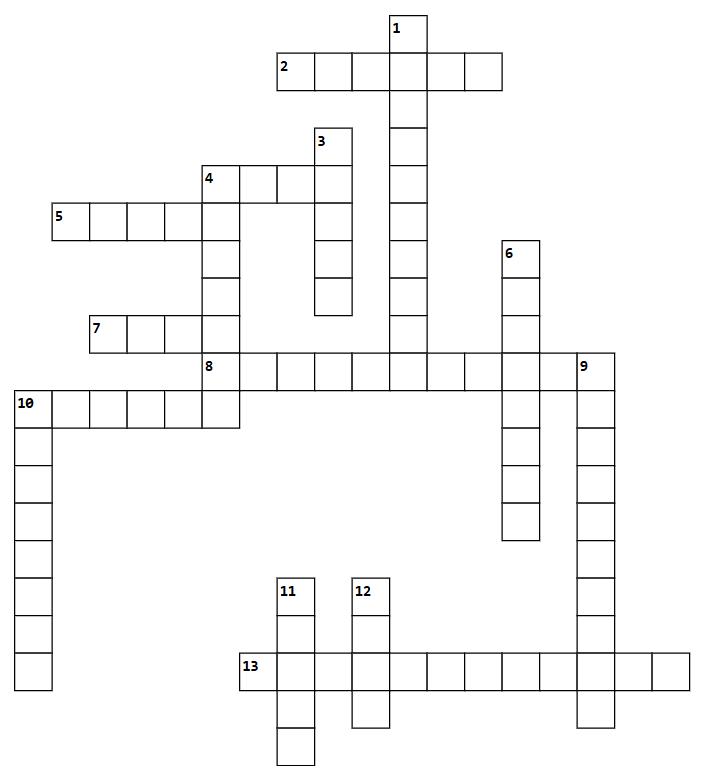




| Suha Sharif NEWS EDITOR
Ross Fleming, one of Mounds View’s longestserving teachers, has decided to retire at the end of this year. As Health and Phy. Ed. teacher, he hopes to leave his students and the community at MVHS with the many lessons he has imparted over the years.
Fleming began teaching at Mounds View in 2003 but has been coaching the boys’ track and field team since 1986. Unlike many teachers who begin teaching fresh out of college, Fleming had an unconventional career path, landing his teaching position in his thirties. From wanting to major in history to working at a health club, he describes each of his prior experiences as failures that finally pushed him to the teaching and coaching positions he has now.
While he started with uncertainty, 40 years later, Fleming says he is living out his dream life. “I get to be exactly where I want to be, doing exactly what I want to do, and that’s a huge blessing,” he said. “This is perfect. It’s a lot of work, [and] it’s really tiring, but it’s working.”
He is passionate about his job and the ways he gets to inspire and motivate students with his health lessons. “I’m able to convey [living a full life to my students], and the kids are buying it, and they’re talking to me about their lifestyle changes. Parents are emailing about the transformation that’s taking place with their kid at home, and they’re thanking me. They wanted this for their kid, but it took a different voice, and I was that voice, and so that was really gratifying,” said Fleming.
“I get to be exactly where I want to be, doing exactly what I want to do. And that’s a huge blessing.”
Ross Fleming, P.E. & health teacher
Known for his strict teaching and coaching, Fleming has also helped instill good habits in his students, including grit, respect and hard work. He enjoys challenging his students, whether through insightful les-
sons or even his frequent bantering. “In class — I don’t know if many people like this — but I like how serious he was about it. He wouldn’t take any crap from anyone. He’d make sure that he stayed on topic and that you were a nice, respectful student,” said senior Samuel Geer.
Throughout the years, Fleming’s role as both a teacher and coach allowed him to build deeper relationships with many students as well. “He taught me not to put so much pressure on myself to succeed. He taught me just to accept where I am and just be grateful for where I am. He’s like, ‘I trust you. You just got to trust yourself.’ So that helped me to have a great year last year with track,” Geer said.
A decade ago, Fleming had said that what he most dreaded was retirement, and such sentiments were visible among his current students. “I was honestly surprised he’s retiring this early, since he seems so active that he wouldn’t retire,” senior Spencer Olson said. However, Fleming said that he wanted to retire on his own terms this year, allowing the school and students to remember him as the hard-hitting, full-of-energy teacher he is.
Fleming has many plans for retirement, including read-

ing up to 60 books per year and hoping to make it through the “well over 2,000 books” he has around his house. “There are documentaries that I’ve saved that I want to see. One of my hobbies is military history and autobiographical or biographical history. I want to read more of those,” he said. No matter what Fleming gets up to in retirement, his
| Gabrielle Skiba STAFF REPORTER
n Jan. 20, Donald Trump was inaugurated for the second time. As promised, he took action from the very beginning by signing 26 executive orders on Inauguration Day alone, more than any U.S. president before. While many have heralded his actions as bold and reforming a broken system, others have derided his actions to be dangerous and a threat to democracy.
One of Trump’s most significant promises was the implementation of mass deportation to tackle the immigration crisis. This has led to deported immigrants being housed at Guantanamo Bay and Immigration and Customs Enforcement (ICE) raids of sensitive locations such as churches, schools and hospitals.
Many immigrant communities have started to pull their children out of schools out of fear, and businesses which rely on these communities have seen a decrease in customers.
“As much as there is a valid argument that we have an immigration problem in America…I don’t believe that the way the current administration is handling it is humane or proper,” said senior Emi Ren. “The false rhetoric that every single person that is going into this country illegally is here to do nefarious
things…is extremely harmful and also villainizes people of color that are coming into this country.”
On the contrary, it seems Trump’s plans to lower the prices of goods for consumers, which had influenced many to vote for him, has been put on the backburner. Groceries, which were a top concern, have now been said to be a “very hard” issue to solve by Trump, partially due to the bird flu driving egg prices up.
Other issues regarding lowering prices for customers could be the tariffs Trump has enacted. While they have just been recently implemented, Trump’s 25% tariff on steel and aluminum and 10% tariff on China could not only lead to a trade war, but also, according to the US Chamber of Commerce, raise prices for consumers. “I don’t see the economic benefit of tariffs, especially when you’re implementing tariffs on some of our closest trading partners, like Canada and Mexico. Why start a trade war when you’re trying to reduce inflation and bring down the cost of consumer goods?” said Social Studies Teacher Scott Oberg.
Furthermore, Trump has mentioned the removal of federal workers that do not align with his political goals or beliefs. Many federal workers, including CIA and FBI work-
ers, have been given a choice to resign and get paid through the end of September or face a possible – and likely – firing down the road. While this move was temporarily blocked by a judge, it was re-established, and according to White House, over 40,000 federal workers have taken the deal and resigned.
Since then, the Trump administration has put around 200,000 federal workers on probation according to the New York Times. They started mass layoffs, firing around 6,700 IRS workers, 2,300 interior department staff and around 2,000 U.S. A.I.D. workers around the world. These actions stem from the goal to save taxpayer money and downsize the government as a whole. However, his tactics are questioned by many. “It’s bad because they’re just firing random people instead of figuring out what the people do. Those [employees] that protect the nuclear weapons, [the administration] accidentally fired them and [he’s] trying to hire them back, but he can’t find them,” said senior James Isaacson.
Many of Trump’s actions have also been challenged in court. On his first day, Trump signed an executive order ending birthright citizenship for children born to non-citizen parents. “I think his birthright citizenship [order] is especially
students will miss him and his unique influence on Mounds View. “The school is definitely [going to] have a big gap to fill with another health teacher. If you look on his wall, he has like hundreds of grad cards there, so he’s obviously touched a lot of people. I think finding a teacher like him is gonna be pretty hard to fill,” said Olson.

concerning because it directly infringes on the 14th Amendment,” said Ren. His order was almost instantly blocked by 22 states that sued the administration. Later, Trump’s administration attempted to freeze up to $3 trillion in federal funding in a move that disrupted Medicaid, Medicare and Social Security payments. It was also shot down by a federal judge who temporarily blocked the order. In regards to foreign policy, Trump has made many controversial statements and moves, including wanting to displace Palestinians in Gaza, buy Greenland from Denmark and rename the Gulf of Mexico to the Gulf of America. “I think one of his strong suits is not foreign policy, especially because
he wanted to name Greenland the ‘red, white, and blue land,’” said Isaacson. “He needs to understand that foreign policy doesn’t involve invading and yelling at other countries.” He has also begun talks with Vladimir Putin regarding the ongoing Russo-Ukrainian war that noticeably excluded Volodymyr Zelensky, Ukraine’s president. “I’m confused. In the first month of the Trump administration, one of his campaign promises was to not get involved in foreign entanglements,” said Oberg.
As of now, it is unclear what the rest of Trump’s term will look like and what the long term effects of his actions during presidency will be.
ith many Mounds View students having free hours, there has always been a question of where to put them during the school day. In years past, the library has been the primary location for students during free hours. However, two years ago, school administrators changed the location of free hours to the forum. With the forum being less adapted for student use, I strongly recommend returning free hours to the library.
Firstly, it is important to consider why the forum was made the destination for free hours in the first place. One reason was that student supervision was easier in that space. “Supervision is more straightforward here in the forum, and separating the kids who are on study hour or online hours from kids who are using the library for other reasons helps to just keep focused on what the library is for,” said Associate Principal Benjamin Chiri.

Another main issue with free hours in the library was student absenteeism. “There were just many, many kids skipping class, and it was hard to tell who was supposed to be in the library… Kids would come to Mustang Mocha on a pass from their classes, and they’d hang out in the library,” said Chiri. With free hours in the forum, student distraction from other classes is less of an issue according to Chiri. While this initial policy was a response to the rising issues of poor supervision and the goal of maintaining stricter hall monitoring, it is time to reevaluate whether keeping free hours in the forum will continue benefiting students now and in the future.
One of the most obvious issues I have with the forum is its limited space. Rows of seats stacked on each other make it difficult for students to move comfortably throughout the space without awkwardly trying to avoid other people. Not only is the limited space uncomfortable, but loud con-
versations can be easily heard and distract students trying to engage in their schoolwork.
Moreover, the room’s atmosphere is not suited for students. The dim lighting and lack of natural light throughout the day make the area feel gloomy, and it becomes very hot and stuffy from so many people being contained in such a small space. This issue is amplified by rules that do not allow students to go to other spaces without permission from their deans. For example, I have been kicked out of the gym numerous times during free hours even with trainers present and permitting me to use equipment.
On the other hand, the benefits of changing free hours to the library are clear. The library contains many different chairs and desks spread out over a spacious area with large windows allowing natural light to enter the room. This would make it feel much more open for students, and there would be less of an issue with varying temperatures and lighting, which would make free hours more comfortable for students overall.
One of the issues that the

administration brings up with the library is the difficulty of monitoring students in the library. However, this was an issue in the past because librarians were the ones who held most of the responsibility for keeping track of students. Because of the many other things they need to attend to throughout the day and the size of the library, this is a difficult — if not impossible — task. Nonetheless, with the current supervision by paraeducator Paul Cicmil during free hours, there can be more support for providing supervision over students in the library. It is also important to note that few classes regularly meet in the
he future is ours, and our [America’s] golden age has just begun.” Listening to these words — the closing line of President Trump’s second inaugural address — brought me to a different period in history.
The Gilded Age is generally referred to as the period of American history from the late 1870s to the turn of the 20th century. It was characterized by the outward appearance of wealth, prosperity and innovation despite the widespread poverty and political corruption within working cities. Like how gilded objects are covered in a thin layer of gold, America’s labor struggles and regulatory issues were covered by the illusion of opulence and riches (hence the
name “Gilded Age”). Today, I see haunting parallels, both economically and politically, to this period in American history.
A crucial aspect of the Gilded Age was the centralization of the economy by monopolies and large corporations, very much like those we see today. These companies wielded significant market power and were headed by socalled “captains of industry” who accumulated wealth at extremely high rates.

In the 1800s, these ultra-rich and powerful leaders included J.D. Rockefeller, Andrew Carnegie and J.P. Morgan. Today, these same roles are filled by the likes of Elon Musk, Jeff Bezos and Mark Zuckerberg. And like the 19th century, the resulting wealth inequality today is egregiously disproportionate. According to 2024 Federal Reserve data, the wealth held by
the top 0.1% of households in the United States was greater than five times the amount held by the bottom 50%. This extreme concentration of wealth is even worse than that of the Gilded Age, and it comes with many effects that stifle the core tenets of the American dream. Some of these effects include decreased upward economic mobility for working and middle-class people, disproportionate societal influence for the wealthy and a distorted impact on the democratic process.
“This
The impact of the ultrawealthy on the democratic principles of our country in both the Gilded Age and today cannot be understated. Large donations have historically been made to influence the political platform of candidates, leading to legislation that disproportionately benefits the donors and their income sources. In the 1896 election, both Morgan and Rockefeller contributed large sums of money to boost William McKinley’s campaign. McKinley then ceased his support for additional antitrust legislation proposals that would have harmed their companies. Likewise, Musk spent approximately $290 million to elect Donald Trump in the 2024 election cycle. As a result, Trump has proposed a $4.5 trillion tax cut that would substantially benefit wealthy Americans like Musk, Bezos and Zuckerberg the most. He has also begun to sign executive orders that benefit the large corporations they run.
library, leaving the library relatively empty throughout the day. Therefore, returning free hours to the library will also make the space feel alive again instead of an empty, unused space.
With more space and comfort, relocating free hours to the library is a feasible step that will improve the well-being of Mounds View students. While immediately implementing such a change might not be easy, I urge this school’s administration to consider moving free hours back to the library as soon as possible because the benefits will be worth it.
These have come in the form of an IRS hiring freeze (reducing the resources available to audit these companies), a reversal of Biden-era environmental policy (which allows for profits to be valued over the climate) and an act placing the workforce of the Consumer Financial Protection Bureau on leave (which combats price gouging). These actions harm economic consumers, the environment and ultimately Americans as a whole.
As President Trump implements his policy goals and surrounds himself with billionaires, he creates conditions that echo the economic and political state of the Gilded Age. Seeing the vast parallels between that period and contemporary politics, I fear that his proposed “Golden Age of America” will result in the same harmful effects as those experienced in the late 19th century.
| Gloria Liu MDE & SPREAD
EDITOR
Freshman Dante Kytola is on the social media rise, garnering over 30,000 followers on TikTok. From fashion to lifestyle videos, Kytola loves sharing his hobbies with his viewers and hopping on the latest TikTok trends.
Kytola began posting on TikTok roughly two years ago. When his friends started posting on the app, Kytola saw it as an inspiration to start his own account. He did not expect his posts to go viral, but after his second post — a simple video stating his preference for baggy jeans — blew up and received around 6 million views, it sparked his motivation to continue posting about his fashion style.
At first, his content was strictly fashion-related, but as his account grew and his posts


activities and other ideas made his account more relatable to the general public and the fashion community. These videos allowed Kyolta to connect to his audience and build a larger following.
Even so, he still dedicates most of his account to sharing outfits. The overall theme of his fashion content is streetwear, which is his favorite fashion style. Growing up, he was influenced by his father, who is a fan of rap culture — commonly associated with streetwear. “When I was younger, my dad listened to rap music and was into streetwear too, so I think growing up around him, he just put me into that culture,” said Kyolta. Eventually, several streetwear brands caught his eye, including Balenciaga, Acne Studios and Our Legacy.
In addition to general fashion videos, a big part of Kytola’s TikTok is promoting his own clothing. Kytola was also
inspired by his father, a tattoo artist, to create his own clothing company, as he already had an interest in drawing and sewing. Along with his friend, Kytola started their own clothing business in January 2024, called diversity.msp, where they sold their first piece of clothing: a pair of jeans.
After getting their first order, Kytola recalls feeling disappointed. “It didn’t actually really feel good because I expected to sell way more right away, and selling only one or two pairs of jeans right away wasn’t really where I wanted to be,” said Kytola. However, after growing the business for a year now, it has slowly started gaining more attraction, with many of the pieces, such as a selection of artistic jeans and baggy jean shorts, or jorts, selling out.
“When I was younger, my dad listened to rap music and was into streetwear too, so I think growing up around him, he just put me into that culture.”
Dante Kytola, freshman
Kytola likes to come up with clothing designs based on what he feels is best. He starts off by sketching the clothing graphics by hand, coming
up with multiple versions before transferring those ideas to Adobe and making a Tech Pack before sending the designs to a manufacturer. He produces roughly 50 to 75 pieces per clothing. As of now, their business has successfully sold out multiple pieces, with more clothes to come. “I’ve had sweatpants on there. I’ve had hoodies. I’ve had jeans. I’ve had jean shorts,” said Kytola.

Kytola notes one of the coolest opportunities he has gotten since growing his TikTok account was partnering with BeReal in January 2024. Initially, BeReal had reached out to Kytola via a direct message on Instagram asking to collaborate. He created a BeReal ad in his own style and advertised it on his page.
Learning to navigate his clothing business has now given Kytola business experience,

which is something he plans to pursue in college, giving him leverage in his future plans. He has also expressed interest in modeling. His dream is to work with Balenciaga, whether it be modeling or partnerships. “I just like the way they put themselves out there, like their aes

| Sinim Dhiguma ONLINE EIC
Senior Ethan Quehl began posting regularly on his TikTok account, @ethanquehl, in 2023. Amassing over 13.7K followers, his account consists of day-in-the-life content. Currently, Quehl has posted around 623 day-inthe-life posts along with additional videos about general life advice, racking up 479.1K likes across his TikTok.
Q: What is your account name on TikTok?
A: “@ethanquehl”
Q: What is the primary type of content you post on TikTok?
A: “I post daily life videos. I’ll post slideshows. So I
take a picture of what I do all day — like 30 pictures [total] — and I just post those to TikTok. People just like to see what I do.”
Q: What made you want to start posting on TikTok?
A: “In 2023, I started posting and I’ve taken a few breaks since then. It was just an idea that came [to me] and I was like, ‘it seems cool to do that.’ Also, I wanted to make money.”
Q: What have been some highlights since starting your TikTok account?
A: “I do have a video that has like 1.5M views and 150k likes. I don’t want to be the guy who only cares about numbers, [but] it’s still pretty cool to have a
video that’s that big.”
Q: Do you equate your TikTok account to a business?
A: “Not right now, maybe in the future if I grow a little bit bigger, but at the moment I’m still in high school, so maybe once I get into college and I have more time to focus on that stuff. I used to make money from TikTok, but since they changed the rules, you have to be 18.”
Q: Approximately how much time do you spend towards creating and editing TikToks?
A: “I’d say about like 15 to 30 minutes each day. It depends on if I post another video on top of my daily ones. So, like two to three
hours a week.”
Q: Have you faced any hardships in your TikTok journey?
A: “Last year, I posted a questionable video and I guess that kind of shows how I’m still a teenager and maybe social media shouldn’t be for all kinds of teenagers because teenagers still aren’t fully developed. So, I’ve definitely learned a lot through my journey on TikTok, but I think that it’s been worthwhile to go through hardships cause I can learn from that and in the future become better in many things in life, especially on my TikTok and [overall] social media presence.”

| Julia Gronert STAFF REPORTER
In these next couple of months, seniors will hear back from schools and find out where they are going after high school. At many high schools, including Mounds View, there is an Instagram account run by the senior class officers where students can share their future plans, such as attending college or university, the military, trade school or other post-secondary options.
Seniors Henry Collins and Colin Holly Wells decided to submit an acceptance to a threeyear internship at the Royal Eijsbouts Bell Factory in the Netherlands. Unbeknownst to the class officers, the story was a complete lie. Starting with a comment about how senior Spencer Olson’s back posture was so bad that he looked like he was going to work a shift at the Danish bell factory, the comment grew into a full-blown lie with an elaborate backstory. It did not take long to get the false post up once they had submitted it. “All I really had to do was put in a real location, then something that seemed logical, like a three- or four-year internship,” said Collins. Some of Collin and Holly Wells’ friends who were in on the joke helped escalate this by feeding into it. “There is no Royal Eijsbouts Bell factory actually present in Denmark, but there is a bell foundry of the same name located in the Netherlands instead, which we
thought was close enough to be ‘basically’ a real Danish Bell Factory at that point,” said senior Spencer Olson. Quickly after the post, people began to question the validity of this obscure internship, and Collins began to construct a narrative around his decision. “I learned about the history of the bell factory and how bells are founded, as well as ringing methods, and I learned all that in a few days,” said Collins. “And then I made up a story about how my family came from Denmark, and my uncle was able to get me in contact with a small artist and scholarship because of his connection to bell foundries as one descendant of a multi-generational line of bell founders over in Europe.”
“I made up a story about how my family came from Denmark, and my uncle was able to get me in contact with a small artisan scholarship,” Henry Collins, senior
One of the first people to learn about the prank was Shreeya Pavani, one of the senior class officers in charge of reviewing the submissions for the Instagram account. “I really didn’t know what to make of it,”

said Pavani. But like many others, it seemed just obscure enough to be true. “It is pretty crazy, but it’s not so far-fetched that I couldn’t believe it was or even question that it was real,” said Pavani.
The decisions posted to the page caused mixed reactions from many students, as people could not decipher if they were truthful or not. “My initial reaction was very much like, ‘Woah, is this real?’ It definitely was out of left field,” said senior Thomas Baker-Trinity. “I was honestly more surprised that so many people who didn’t know them just insisted they were lying or joking.”
This is one of the first years that this has become an issue for the Instagram account. Originally operating on the
honor system, the senior class officers decided to start requiring evidence in order to validate and post the decision. Collins and Holly Wells both provided proof, using an online internship acceptance letter template. “If it looks apparently obvious that it’s fake, then obviously we don’t post that. But this was kind of a unique case because we don’t really know what an offer letter from the Danish bell factory is supposed to look like,” said Pavani. “So because it seemed generally valid, and they really committed to the bit, we just went with it and decided to post it on the off-chance that it could be true because we didn’t want to invalidate that if it was true.”
She and the other senior class officers have received
backlash for posting the fake decisions. “There’s been a lot of feedback from people saying that they don’t want fake ones to be posted because it takes away from all the people who are actually posting their real decisions,” said Pavani. “I don’t think that people are taking into account the things that we’re trying to balance between being respectful to people and also posting real commitments there.”
Others do not feel that it is that serious. “If it’s just a fun little page to show where people are going, [they] might be open to taking in prank applications or silly applications like that,” said Collins.
Looking ahead, both Collins and Holly Wells are looking to attend a four-year university, but Collins has not completely ruled out bell founding. After lots of intensive learning about the subject, he said that he would possibly be interested in pursuing it. “It’s an interesting enough topic that I think it would be cool to go to another country and learn a science and a craft,” said Collins. Overall, however, Collins and Holly Wells acknowledge the effect that the false decision created for students. “Misinformation is very easy to spread,” said Holly Wells. “I didn’t know how easy it would be if you just seemed wholly convicted in something that seemed just weird enough to be true.”
| Jadyn Heath-Hlavacek STAFF REPORTER
ebruary 2025 marks the 99th Black History Month, first established in 1926 and officially recognized in 1976. This month brings light to the culture, history and struggles of the African American people. Here at Mounds View, the Black Student Union (BSU) celebrates this month by giving Black students a safe space and giving back to the community.
The BSU’s hard work goes into creating a safe space for Black students in the school. “I hope that Black students at Mounds View can be more seen and heard and know that there’s a space for them where they can [be] free and comfortable to be who they are,” said junior Nungswi Sackhi, a leader at the BSU meetings.
BSU also creates a welcoming environment for students to strengthen bonds with each other. “I think that BSU leaves a huge impact on our community because it is a great way to meet other Black students at Mounds View and

build connections with people you may not talk to on a daily basis,” said junior Alyssa Gatumbo. “Building community means creating and strengthening relationships with others in your community and creating a space for everyone to feel accepted and connected.”
In addition, BSU does many fundraising events, donating to places that support their core belief of supporting and building community.
One of those recipients is the
Minnesota African American Heritage Museum and Gallery (MAAHMG), an organization that documents and highlights experiences and achievements of Minnesotan African Americans. “We went to [MAAHMG] for our field trip during May last school year because we wanted to send them a donation last year, but we didn’t have enough time or resources, but [this year] we made enough money [to donate],” said Gatumbo.
From Feb. 11-28, BSU also
collected school supplies in the student services office for elementary schools in the Mounds View school district. “Since the theme of education is important to the Black community we should be making efforts to provide to who we can. So, for this project we decided to give back to our Mounds View community, providing to all six of our amazing elementary schools,” said senior Jayda McAdams.
Some of BSU’s other service projects include selling
BSU t-shirts during early February during lunches and hosting a Kids Club for Communication Night on Feb. 27. The goal of this club was to provide parents a free, supervised place with games and snacks to drop off their younger kids while meeting with teachers.
Discussions of possible future fundraisers and community events circle the club, including planning monthly BSU movie nights. “There are other things that we’ve talked about doing that could be fundraisers or could simply be fun community activities. One example is we’re in the works of planning a series of BSU movie nights, hopefully once a month for the rest of the school year is what we’re looking at,” said BSU advisor and associate principal Ben Chiri. Mounds View BSU thrives at creating a unique culture that reaches out to leave a lasting impression. “I hope to leave a positive mark for future students and I hope to be able to reach enough people through the work that we do,” said Gatumbo.
| Mara Peacock FEATURES EDITOR
Over the past few decades, the term “climate change” has garnered more and more attention in media and science. With conspiracies and backless claims on the causes of climate change, it can be difficult to ascertain its true effects and impacts and how they have worsened. 2024 provided many examples of the direct, immediate effects of climate change and how it compares to previous ones.
One of the most notable effects of the climate crisis has been more constant, severe natural disasters. Starting in September 2024, Hurricane Helene was another wide-scale natural disaster, affecting areas of North Carolina and Virginia as a Category 4 hurricane. This tropical storm was followed by a Category 3 Hurricane Milton in October 2024, affecting parts of Florida. Both severe storms represent the larger trend of more intense hurricanes as the ocean temperatures get warmer. These increasing temperatures lead to increased wind speeds, according to the Center for Climate and Energy Solutions, along with other climate-related factors. Hurricane activity in general has also increased significantly in the past few decades as more severe tropical storms become more common.
In Los Angeles, recent wildfires have sparked nationwide discussion on how climate change may have exacerbated them. The wildfires began in January 2025, and The World Weather Attribution reported that due to Los Angeles’ current climate, there was a 35% increase in the likelihood of wildfires, compared to previous years. Increased dryness, drought and rising temperatures can affect the likelihood of wildfires, all of which are connected with climate change as reported by the US Environmental Protection Agency. Climate change is known for its effects on human life and health, including the widelyknown effect of global warming. As a result of the warming planet, humans and many living things are more exposed and vulnerable to conditions such
as heat stroke and dehydration.
The climate also affects the accessibility of food and water sources. Droughts, changing temperatures and water stress lead to the decrease in the ability to get food and water according to the National Oceanic and Atmospheric Administration. Climate change affects many aspects of life, leading to big concerns about the world’s climate in the future. “The rising ocean levels and the natural disasters [have been] getting worse over the past few years, like the California wildfires and the houses in Panama that have been getting taken over by sea levels,” said senior Greta Seyfarth.
“I think that people don’t really see the direct effects of [climate change] in front of them all the time so it’s easy to ignore it. ”
Greta Seyfarth, senior
The rising sea levels have caused a global phenomenon, as the ocean threatens to catch up to coastal cities and countries.
“There’s land that is disappearing, coastal land, and especially in low elevation countries, they will be sunk, probably in our lifetimes,” said junior Sam Aasen. NASA reports that the United States’ East and Gulf Coasts are highly vulnerable areas, along with areas in Asia and islands around the world.
In Minnesota, the climate crisis has affected many things. According to the Minnesota Pollution Control Agency, floods and extreme weather in Minnesota have increased greatly over the years. Winter temperatures have increased about 4.9 degrees fahrenheit in southern Minnesota and 7.3 degrees in northern Minnesota from 1895 to 2021. Also in Minnesota, the natural environment is not always properly protected, such as increased mining in the Boundary Waters, which leads to direct climate change as humans manipulate the environment. Mining for metals and minerals leads to increased greenhouse gas emis-
sions — along with the energy usage needed for the process — and the destruction of natural habitats.
In 2024, Minnesota experienced drastic climate abnormalities, ranging from record-breaking dry spells and precipitation, demonstrating another consequence of climate change. The Minnesota Department of Natural Resources claims the dry spells from February to March and from September to October created an unseen dry season. Between the dry spells, June and July featured an extremely notable wet season, along with one of the largest hail storms in Minnesota’s history. The contrasting climate of Minnesota’s seasons made 2024 a very unpredictable year. NASA has found that global warming connected with climate change strongly correlates to extreme droughts and wet seasons, as the warm air can either cause moisture to evaporate or hold moisture to precipitate.
With countless effects and dangers of climate change, many scientists and experts believe everyone should do their part to help prevent the worsening of the planet. Organizations often take it upon themselves to do their part and spread the message of stopping climate change, such as the infamous Climate Clock featured in Times Square. The clock displays the amount of time the world has to effectively stop global warming, as the Earth reaches “a point of no return.”
The Climate Clock provides a way to show people why taking action against environmental degradation is crucial, but also how humans can come together to stop it in time. “I think that people don’t really see the direct effects of [climate change] in front of them all the time so it’s easy to ignore it. Especially because it progresses in a way that’s not really in your face,” said Seyfarth.
Although climate change seems like a faraway issue for many people, it continues to evolve. 2024 and the start of 2025 have shown the world some of the devastating effects of climate change through extreme temperatures and unforeseen natural disasters.
| Lillian Landberg FEATURES EDITOR
The subject of climate change has been hotly debated in political campaigns. Ever since the Supreme Court ruled the regulation of greenhouse gases in 2007 as a federal issue, the spotlight on climate change has strongly persisted. Like most political issues, climate change itself has earned a fair share of theories to the point where some believe that the phenomenon does not exist.
The idea of a “green agenda” — a plan to protect the environment and strongly address climate change and the growth of nuclear power — stirs up these theories and fosters widespread distrust. “[Climate change] has caused very extremely harmful rhetoric and leads to distrust in scientific
conspiracies
“When you look at the amount of suffering that these people went through and your first reaction is, ‘It’s a conspiracy. They did this,’ just take a step back.”
Jonin Morgan, senior
Climate change causes more natural disasters according to The United States Geological Survey. One of these natural disasters happened recently in the past year when Hurricane Helene and Hurricane Milton hit the coast of Flor

in the area. As a result, some conspiracy theorists believed that these events were false on the pretense that the Biden administration created these storms to hinder red states from voting to secure a win for former vice president Kamala Harris according to AP News. However, some Mounds View students are very doubtful of this theory. “[Hurricanes devastating red states] is just a coincidence. There’s no way anyone is controlling that hurricane,” said sophomore Roman Buzan.
In addition, a long-standing theory about the California wildfires revitalizes itself each time the disaster occurs. The 10th most deadly fire, the Palisades fire, occurred in January 2025, killing 15 people. The cause for this fire is still undetermined, but many have taken it into their own hands to find the source of the fires. Ac
ons, more commonly referred to as DEWs. These weapons, allegedly, were stationed in space. The two ways they start fires is through shooting lasers to the state of California or agitating microwave systems to ignite flames in populous areas. Another theory was the government purposefully withholding water supply to prevent firefighters from using it to combat the aggressive and violent spread of the Palisades Fire. According to CBS News, these claims have been debunked by multiple scientists. “When you look at the amount of suffering that these people went through and your first reaction is, ‘It’s a conspiracy. They did this,’ just take a step back,” said senior Jonin Morgan. Instead of conspiracies, scientists say that common causes for wildfires are dry winds, droughts and irresponsible campers and hikers, among other

| Isabel Li EDITOR-IN-CHIEF
ith thunderous applause and cheers from the crowd, President Donald Trump proudly declared, “We will drill, baby, drill,” at his inauguration speech. Just in his first month, Trump has attempted to overturn many climate-related policies from the Biden administration, with drilling being only one of them. His second term has raised environmental concerns as he favors economic growth and deregulation over environmental protection.
On Jan. 20, Trump became the first president of the United States to declare a “national energy emergency,” giving him the power to avoid bureaucratic rules and prioritize energy development. He hoped to increase domestic energy production amid alleged energy shortages and speed up fossil fuel projects by approving permits and allowing projects to bypass environmental regulations.
Yet, there is little evidence to suggest that the U.S. is truly experiencing an energy crisis. The U.S. is the number one producer of oil in the world for the sixth year in a row, averaging 12.9 million barrels per day according to Reuters. Production has only continued to increase, with some scientists claiming that there may soon be an oversupply of fossil fuels. “I don’t really see any emergency going on right now. I think that [Trump’s] most likely just doing that so he gains more power. Just by declaring an emergency, he can do more things,” said senior Kyle Dolbow.
One of his most controversial executive orders thus far is “Unleashing Alaska’s Extraordinary Resource Potential.” This sets the framework for lifting prior drilling restrictions on the Arctic National Wildlife Refuge and accelerates the development of energy projects in the area. Along with many conservatives, Trump views drilling bans in the refuge as an “assault on Alaska’s sovereignty,” halting the prospects of a thriving oil and gas industry. With about 625 million acres of land open again, Alaskan politicians like Governor Mike Dunleavy
are excited about the new economic prospects and job boosts this could bring.
Others are concerned about the damage to the environment. According to the Arctic Institute, extensive drilling — as well as the threat of oil spills from explosions or accidents — can not only harm Arctic animals, but also the indigenous people who rely on these animals. “Opening up these pristine areas like the Arctic National Wildlife Refuge will destroy these climates and these ecosystems which are extremely important to the world. These ecosystems are so fragile, and they can only exist in these really specific standards that oil drilling and the threat of oil spills will destroy, so that’s a very scary thing,” said senior Jonin Morgan.
In Minnesota specifically, Trump’s “Unleashing Energy Act,” will potentially reopen the Boundary Waters Canoe Area to mining, overturning the 20-year ban that Biden enacted on Jan. 26, 2023. According to MiningMinnesota, the prospect of the untapped copper and nickel mining could bring over 750 jobs into the area, as well as $2 billion in revenue. However, like Arctic drilling, sulfuric acid and mercury from these mines could poison the water.
“I feel like we as Minnesotans should be looking towards this because the Boundary Waters [is] not only a beautiful recreational area, but it’s also crucial to the indigenous groups’ culture and their lives in that area. They rely on those waters and the food and the nutrients that comes from that area because the whole ecosystem is based off of that water,” said Morgan.
In addition to these mining regulations, Trump signed an executive order to pull the United States out of the Paris Agreement for the second time. He argues that it is an economic burden on the United States to not only have to comply with stricter emission regulations — which could hurt manufacturing industries — but also to fund climate initiatives for developing countries in the Green Climate Fund. This has sparked backlash from many, given the powerful influence the United States has on international climate policies. “[The Paris
Agreement] is super duper important because they set climate goals, and they fund different sustainable energy initiatives in lower income countries, as well as climate justice groups… so that’s a real shame that we’re pulling out of that because we’re also one of the major players for actually setting the policy there,” said senior Sarah Pederson.
However, others believe that the Paris Agreement is more useless than helpful. “Many countries in the agreement are not fulfilling their stated goals, so I view it as just kind of like…virtue signaling…like saying that we’re going to make our environment better but not actually doing it because no one wants to make the hard steps of having an economic impact by transitioning to green energy,” said Dolbow.
Trump’s other notable climate-related plans include weakening the Endangered Species Act to lift restrictions on controversial projects that may harm vulnerable species, halting wind development and stopping the transition from plastic to paper straws.
Despite many people’s concerns about the next four years’ climate policies, Trump’s power to make significant policy changes remains restricted because of the inherent checks and balances in the U.S. government. “I think a lot of his executive orders are going to get struck down in court as unconstitutional or not in the interest of people, so all these big orders look really scary, but… long term, a lot of them won’t have a[s] big of [an] effect as they feel like they will now,” said senior Greta Seyfarth. Much of the climate battle has come down to ideological differences and disagreements about the severity of the climate crisis. Whether people agree with his policies or not, Trump’s slew of executive orders have sent a clear message: that energy development is at the forefront of his priorities.


Genetically modified organisms (GMOs) are organisms whose DNA has been altered using genetic engineering to introduce specific traits, such as pest resistance, higher yields or improved nutritional content. Unlike traditional breeding, genetic modification allows for precise changes at the molecular level, often by inserting genes from other organisms. These artificial changes cause public debate over their role in food production.
| Sean Oh STAFF REPORTER
Famous English economist Thomas Malthus said, “The power of population is indefinitely greater than the power in the earth to produce subsistence for man.” However, thanks to progressions in agricultural technology, like GMOs, he was proven wrong. The purpose of farming is to produce food for consumption. According to the USDA, average organic crop yields per acre are anywhere from 10-15% less than GMO crops, and 100 million more acres of land (which is roughly the size of California) would have to be cultivated for organic crops to produce the same amount as GMOs. Organic crops’ lower yields per acre would only exacerbate issues of land overuse. GMOs are able to outcompete organic crops in yield sizes because, according to Alliance For Science, GMOs can boost crop yields by reducing maturity time and by making crops more insect, disease and drought resistant. GMOs allow for more crops and healthier crops. GMOs are designed to help fulfill the purpose of farming and producing food, and they work.
GMOs’ benefits do not stop at only yields; they also are less taxing on the environment. In a study performed by PG Economics, they found
that GMO crops can lower carbon emissions related to farming, saving 27 billion kg of carbon dioxide emissions compared to organic crops — the equivalent of removing 11.9 million cars from the road for one year. This is because organic farmers are forced to rely more heavily on carbon-emission intensive tilling than GMO farmers. Organic farming is also more climatically harmful because of its reliance on composting, which produces harmful methane gas when done anaerobically (without oxygen).
Many common arguments and beliefs against GMOs are baseless and simply rumors. One of these common misconceptions is that GMOs are linked to cancer. However, according to the American Cancer Society, there is no evidence to link GMO intake and an increased risk of cancer. These misconceptions cause people to believe that GMOs negatively affect health when, in fact, GMOs can actually have positive effects on health for consumers. For example, insect repellent GMOs reduce the use of pesticides and in turn reduce pesticide poisonings. These positive effects are even more prevalent in developing countries because farmers in poorer, developing countries often lack the proper applica-
tion tools for safe pesticide application according to a study performed by North Carolina State.
GMOs also help to combat malnutrition in similarly developing countries. As per the official Golden Rice Project website, a humanitarian organization, many developing countries rely on rice as a primary source of nutrition. Rice is mostly an excellent form of cheap sustenance in these countries, but the common rice lacks vitamin A, which leads to vitamin A deficiencies and compromises the immune systems of around 40% of children under the age of five in the developing world. GMOs, however, can solve this issue by incorporating vitamin A into a genetically modified strain of rice, called “Golden Rice.” The widespread adoption of Golden Rice from the Golden Rice Project in the developing world improves adolescent health — all because of the scientific innovation that is the GMO.
GMOs are undoubtedly better than non-modified, or organic crops, which are outclassed in every metric of success. GMOs are better for the environment, better for crop yield and can even pave the way for better conditions in the developing world.
Across America, unhealthy and unsustainable farming practices are threatening our environment, wildlife and even human health. These practices involve the widespread use of genetically modified organisms (GMOs) — a form of crop engineering that has led to serious ecological and health concerns.
GMOs can have significant ecological consequences, particularly due to the excessive use of herbicides. According to the Canadian Biotechnology Action Network, GMOs can have severe consequences on the environment around a farm. Essentially, farmers and scientists genetically modify their crops to be more or completely resistant to certain herbicides. Then, farmers use an unhealthy and damaging amount of herbicide to clear plants other than the desired crops. This practice results in herbicide runoff, contaminating soil and water while harming surrounding ecosystems. A notable example is the destruction of the Monarch Butterflies’ primary food source, the Milkweed plant. From a study by the National Academy of Science, because GMOs are engineered to resist herbicides, when herbicides are sprayed indiscriminately across crop fields, all non-resistant plants are damaged. This process endangers ecosystems as well as food sources for many animals.
This practice results in herbicide runoff, contaminating soil and water while harming surrounding ecosystems.
These herbicides not only have damaging effects on local ecosystems, but also on ecosystems thousands of miles away. This problem is known as genetic contamination, which is the spread of GM (genetically modified) DNA from GMOs to normal plants. From an NPR reported study, a strand of GM Feral Canola — a plant that produces canola oil — was found 3,000 miles away from its birthplace in North Dakota. This kind of movement shows just how far these “escapes” of GMOs can travel. Feral GMOs can also spread and evolve into new, more resistant plants, which in turn can spread to other farms. Then, as reported by PLOS One, since the feral GMOs already have anti-herbicide genes, the farmers have almost no way to stop them from taking nutrients from the crops they want to grow.
As well as hurting ecosystems, DNA splicing in consumer foods can also cause great harm to communities across the nation. From studies surveyed by the Nation-
al Library of Medicine, introducing genetically modified food into different animals leads to an increase in toxicity in multiple organs with negative effects on hepatic, pancreatic, renal and reproductive systems. This toxicity is due to the GM DNA that organisms have to break down. If an organism cannot break down a new, lab-created strand of GM DNA from a plant, waste can pile up in their organs and lead to toxicity.
Another health concern associated with GMOs is allergic reactions derived from spliced and infused DNA between plant species. Business Insider describes how a traditional GM soybean plant infused with Brazil Nut DNA can cause allergic reactions for people with nut allergies without them noticing they are consuming nut DNA at all. The problem is that when people don’t know what kind of DNA they are consuming from different plants, surprise allergic reactions can occur.
In the end, whether by herbicide runoff or harm to humans, it is clear that GMOs are harming our ecosystems as well as human health. With that said, the best way to keep families safer and healthier while also supporting sustainable growing practices is to steer clear of GMOs.
| Matthew Betti and Carter Ballman GOOD QUESTIONS EDITOR and STAFF REPORTER
ounds View offers a range of academic programs and extracurricular opportunities, many of which aim to prepare students for life after high school, whether they plan on going to college or take a different path. The school’s academic offerings stand out, with several forms of college classes like Advanced Placement (AP), College in School (CIS) and Anoka Ramsey Community College (ARCC) courses, which simulate the rigor of college courses while giving students a chance for college credit in high school.
Along with these courses, Mounds View offers several classes that aim to give students certain practical skills that they can carry with them after high school, like financial literacy and strong communication. In addition to its academic offerings, Mounds View organizes events like career fairs, field trips and internship opportunities to give students exposure to various career fields.
Mounds View offers 26 different AP courses, far exceeding the national average of around 10 AP courses available at most high schools. This variety gives students a chance to learn a diverse set of subjects in-depth while exploring potential majors or careers. “All the AP classes I’ve taken have helped me prepare for college classes and manage workloads
for classes,” says Mounds View alumni Avelyn Anderson. CIS and ARCC courses offer similar benefits with typically less academic rigor and without having to take the end-of-year AP exam; however they can have more restrictions around college credit. Usually those credits are taken by many two and four year institutions in Minnesota, whereas, depending on the score on the AP exam, a majority of the colleges in the nation will take the credit for AP courses.
“All the AP classes I’ve taken have helped me prepare for college classes and manage workloads for classes.”
Avelyn Anderson, Mounds View Alumni
Mounds View also offers several courses that give students a more direct, wellrounded education beyond traditional academics. Courses like Welding 101 and Small Engines and Power Sports Mechanics introduce students to a hands-on learning experience, giving various technical skills and exposing them to a career without the need for traditional four year schooling. Another
course, Speech, builds strong public speaking and communication skills, which are essential for nearly every profession. Additionally, Personal Finance — which recently became a state-wide requirement — equips students with skills such as budgeting, taxes and credit management, which are crucial for navigating adulthood. These courses, along with many others, can help students start to develop important skills that are not taught in a traditional setting, while also giving them exposure to certain career fields, giving them better opportunities for their future.
Extracurricular activities can also play a major role in preparing students for life after high school. Clubs like DECA and Economics club allow students to learn the fundamental aspects of business while also learning skills like leadership, problem solving and communication.
In addition to its academic offerings, Mounds View organizes events like career fairs, field trips and internship or shadow opportunities. “We try to get as much information, and we really try to connect with our local employers as much as we can, and we try to set students up with local opportunities. We also give students opportunities like touring a manufacturing plant, or going to a career fair, or maybe having speakers come in and talk about their careers. We really try to give students that oppor-

tunity to see what it would be like to go into the workforce,” said Madison Hendrickson, College and Career Coordinator. These events give students exposure to different industries and allow them to network with professionals, gaining insights into potential careers. While deciding what to do after high school may seem overwhelming, the best way to figure it out is with real-world experiences. “I really try to encourage students to involve themselves in as many experiences as you can. Students think that they need to have this big career experience, but you’re going to learn so many valuable things about your interests and your likes through just a basic summer job and through just simple experiences that maybe it’s a one-day job shadow, maybe it’s you talk to your neighbor or your mom’s friend,
and they work for this company that sounds interesting. Talk to them about it. It’s those conversions that really help students figure those things out,” said Hendrickson. Through these various academic and extracurricular offerings, Mounds View provides students opportunities to receive real-world experience, develop essential skills and explore potential careers. Whether a student is aiming for college, trade school or the workforce, the resources are there. It is up to them to put in the work, challenge themselves and take full advantage of the opportunities available.
| Grayson Then STAFF REPORTER
At the start of the school year, Mounds View implemented an adjusted grading system compared to previous years. The change shifted the parameters of the grading scale, including increasing the minimum grade for an A from 3.4 to 3.51 and decreasing the minimum grade for passing a class from 1.5 to 1.0. The move has received mixed reception from students, staff and parents, with many wondering why the grading scale changed.
According to Principal Rob Reetz, there were numerous reasons why the scale changed, including the need to have the same grading scale as Irondale. For years, the two schools had different systems, and Reetz believes this caused consistency problems within the district. “Mounds View and Irondale had different ideas as to how to ensure rigor on a four point scale,” said Reetz. “It created, in my mind, a disadvantage for students here because they were failing courses that they would have been passing
had they taken them at Irondale.”
“The grade a kid is most likely to receive in this school remains an A, and it’s not close [to other grades].”
Robert Reetz, Mounds View Principal
Reetz saw that something needed to change in order to make the grading system fair. “We have an equity promise that says the school a student attends will not be a predictor of their success,” he said. Before the change, the minimum grade needed to pass a class at Mounds View was a 1.5, while it was a 0.8 at Irondale. To make the scale more equitable, the district changed the passing grade to 1.0 at both schools and established an equal-interval scale, using a 0.75-point difference between each letter grade including pluses and minuses, which resulted in an A moving to 3.51.
The change has generated mixed reactions from the school community. According to a survey of 142 Mounds View students, 78.9% said that they did not like the new scale, and 73.2% felt that it hurt their grades. These students feel that it brings more students’ grades down in the process. “Instead of changing the grading scale, I would focus on helping the people who need help, instead of bringing everyone down to the same level,” said junior Emmett Heilman.
However, Reetz pointed out other parts of the system that benefited students this past semester, including the effort to reduce implicit bias from teachers by standardizing the weight of assignments. In the past, teachers could weigh assignments however they wanted. “We had one teacher weigh an assessment at 70 and all other assessments at four. So the overall score grade for that teacher in that course was a single assessment,” Reetz said. “That, to me, was not fair.”
Now, performance assignments can only be weighted either two or four performance points.
The impact of assignments

on a student’s grade also shifted, with performance assessments originally being worth 80% of their grade and practice assignments being worth 20%. The new plan changed that to 85% performance and 15% practice, or 75% performance if there is a 10% final assessment.
Although many students find it more difficult to get an A, Reetz believes that the change to assignment weights, in general, counterbalances this shift. “I think actually the 0.11 difference, if you start talking to math teachers, is almost negligible in comparison to the huge swings in a kid’s grade based on how heavily weighted a single assessment was.” said Reetz. “The grade a kid is most
likely to receive in this school remains an A, and it’s not close [to other grades].”
Mounds View changed the grading system with the goal of creating equity and giving all students a fair opportunity to succeed. Reetz hopes that the changes make the system more understandable and help the student body as a whole. “The idea is we’re focused less on points and grades and focused more on what learning you need to do in order to get this score,” Reetz said.
| Isabella Kunc MANAGING EDITOR
Five years ago, the idea that started Happy Monday & Co became a reality. From a small pottery brand in one owner’s basement, they truly began as a “coffee cart” that popped up in events all around the Twin Cities. All the while, they were looking for a permanent location. After a local church moved out, they had a grand opening on Sept. 14, 2024 at their new location at
2420 Cleveland Ave N, Roseville, MN. Happy Monday & Co is open almost everyday from 7 a.m. to 7 p.m. and beyond coffee, their menu includes Mogi bagels and Heggies pizza.
I loved the coffee shop from the moment I walked in.
The tall, large windows let in so much light and the swirling snow outside created a cozy feeling. The place looks like a refurbished warehouse, all one big room with echoey walls, but the boho style with comfortable couches, carpets and plants and defined sitting and studying areas created a nice atmosphere.
The menu is not robust, but has all the well-loved classics. I leaned more towards a noncoffee drink and decided upon the chai latte over the matcha only because of the comparing prices. Of course I did still have to try some coffee so I ordered a cappuccino. I thought about ordering food, but the selection was small, and I decided against it.

The drinks were ready quickly, and the chai latte had a cute milky leaf on the top. My first impression of the chai was a delicious, warm and spice-full sip with a light and airy cream. However, as I drank it, I realized it did not have quite as flavorful a punch as I would have liked and tasted a lot like hot milk. Overall, it was not bad by any means, but could have had a stronger chai flavor.
“The place looks like a refurbished warehouse, all one big room with echoey walls, but the boho style with comfortable couches, carpets and plants and defined sitting and studying areas created a nice atmosphere.”
Isabella Kunc, senior
The cappuccino came in an adorable ceramic mug and a tray with a little shot glass of sparkling water. It felt very Italian and authentic. My first

impression of it was also delicious, it had a deep and rich flavor and tasted like well-brewed, dark coffee. My only caveat was that it had a bit too much of a bitter aftertaste, more than the normal coffee bitterness. I would not by any means call myself a coffee connoisseur, but I do enjoy a good cup of straight black coffee and have tried good Italian cappuccinos. It did feel very authentic, though, and I loved being able to chase it down with the sparkling water. I am not sure if the aftertaste is some kind of acquired taste or
a kind of accident, but I would not recommend the cappuccino if you do not like bitter coffee. The cafe as a whole was a lovely experience, even if I did feel surrounded by millennials, but the prices felt quite reasonable and the vibes were immaculate. I would definitely visit again and bring a friend for a cozy afternoon chat. Overall, I rate Happy Monday & Co a 4 out of 5 as an adorable place to visit for a new experience out of your normal routine.
he Taco Bell Defy is a concept that focuses on the quick customer service aspects of a fast food restaurant. In doing this, they improved service times to two minutes or less and reduced customer contact with employ-
ees by creating a two-story Taco Bell. The lower level has three lanes for the customers to pick up their food, and the second story is for employees to cook the food and send the order down by elevator. Each lane consists of an automated conveyor machine that distributes orders, with a conventional drive-thru and three other online pick-up lines. Taco Bell Defy is currently located in Brooklyn Park, MN and is the only one in the world.
Upon my first look at the restaurant, it appeared similar to what a conventional bank looks like. But as I arrived at the

drive-thru, I noticed that there was no dining room accessible to customers. My experience at the drive-thru seemed normal until I stopped at the window. The food I ordered had come down on an elevator to the employee working the drive-thru.
Unfamiliar with the Taco Bell menu, I decided to order the fan favorites: the Crunchwrap Supreme, Baja Blast, and Nacho Fries to end it off — that and a dollar menu item so that I could order for the pick-up line.
The Crunchwrap Supreme came in a plastic cover and left an oil stain. Although the impression and looks of it were bad, my first taste of it was rejuvenating. The mix of the different layers consisting of meat, cheese, veggies and sauces had a delightful crunch. Despite the satisfying taste of the food, the process of eating it did not have quite the elegance. Sauces continued to spill out of the bag and caused a mess, which was a definite major downside.
My two sides were by far better than my main entrée. I preferred the Baja Blast and my Nacho fries due to their lack of sogginess and the satisfaction they brought. The two sides complemented each other fan-
tastically, as I would munch on the fries and take a sip of my drink. It was a perfect combo. I never got the full experience of Taco Bell’s concept of Defy by observing the singlelane drive-thru, so I continued the circle around the restaurant to create an online pick-up order. Shortly after, my food was ready to be picked up, and I got into one of the three pick-up lines, which were all empty.
“Nearing the end of my experience with this new concept of Taco Bell, I felt weary of how this is expected to fan out in the future. I felt sad after buying my food because I never got to talk to anybody.”
Elijah Mattfield, senior
The process needed to go through to pick up my food was confusing. The QR code scanner was finicky as I showed my order. After no success in multiple attempts of scanning, I resorted to manually typing
in my order number. The order line seemed more accessible to larger vehicles as it was difficult to use the directories throughout the line, causing more of a hassle to pick up my food. Finally reaching the food elevator, I waited for about five minutes until my food scaled down on the platform.
Nearing the end of my experience with this new concept of Taco Bell, I felt weary of how this is expected to fan out in the future. I felt sad after buying my food because I never got to talk to anybody besides the single lane with an employee. I like the concept of customer service and interacting with somebody before spending your money to eat.
Despite the lackluster process of the highly anticipated Taco Bell’s Defy pick-up, the experience was fun and unique. I believe the concept could be great in the sense of a social distancing environment, such as for COVID-19, due to their human interaction limitation. Overall, the Taco Bell Defy deserves a 3.2 / 5.
| Matthew Betti
GOOD QUESTIONS EDITOR
The Mounds View Boys Swim and Dive team is nearing the end of an exciting season. With several athletes delivering impressive performances, standout swimmers like juniors Danny Bai, Ben Lawrence and senior captain Peyton Kwan have led the charge in important moments like the hard fought win in the Stillwater dual meet. Bai broke the Park High School record for 100 meter backstroke while placing first in two of his heats, along with Lawrence and Kwan both placing first in their own heats. Their strong performances lead to Mounds View’s first win in the Stillwater dual meet in 13 years.
“[The win] was a huge boost to team morale. It’s proof the work that we put in practice is making us faster and better swimmers every day.”
Joseph Cole, senior
After several experienced seniors graduated last year, Mounds View entered this season with a much younger roster. However, many of these ath-

letes were already familiar with competitive swimming, competing outside of school in their own clubs. “A lot of rookies we had were already pretty good,” said head coach Chris Yauch. “They had swam in a swim club so they were pretty much ready to go.”
The influx of younger swimmers has also changed the team dynamic in ways beyond just performance. “Their energy is different. Their music taste is different,” said Cole. “Adapting to that has been awkward at times, but they’ve all been
really excited and just happy to be here. It’s been fun watching them grow and get closer.”
While many of the younger athletes are still developing, many have committed to offseason training through club or just casual swimming, setting a solid foundation for the future.
With the significant shift in team composition from last year, leadership from the upperclassmen has played a crucial role in shaping the team’s chemistry and performance.
Senior captains Cole, Kwan and Balraj Gill have worked hard to
create a positive environment for the swim team throughout the season. “We’re first and foremost a team that values our friendships,” said Cole. “At the end of the day, the wins and losses don’t define us. What matters most is the moments we share as a team.”
One key aspect of the team’s preparation for the season has been training with a focus on dropping time. At the start of the season, the coaching staff evaluates their swimmers’ speeds and then designs challenging drills based on their
performance. The training process also includes an intense conditioning phase, followed by a taper period where their workload is gradually reduced — a crucial part of training for endurance sports like swimming. Since the athletes’ bodies are used to intense training, they are able to increase their energy from this taper, better preparing for championship meets at the end of the season.
“Our goals for state are honestly just going after personal records and enjoying our races.”
Peyton Kwan, senior
Mounds View Boys Swim and Dive continue to work in both practice and competition as the season progresses, grasping at every chance for improvement. As the postseason approaches, the team has continued working toward shaving more time off their races and getting as many swimmers qualified for state as possible. While this year can be seen as a period of transition for many, the program’s future lies within the hands of their athletes’ hard work, raw talent and stable coaching.
How long have you been dancing for?
I’ve been dancing since I was four years old — so 14 years now — and I mainly started because it’s really the only sport that stuck with me. I did soccer, and I would just pick dandelions.
Why did you join the Mounds View dance team?
I kind of stopped [dancing studio] at the perfect spot. COVID came up, and that was our seventh grade year, and at that point, everything was online, and I hated dancing online because I had to dance in my room, and [there] wasn’t a lot of space. And so we had our final recital that year, and I knew then thatI kind of wanted a fresh start. My eighth grade year I joined [the Mounds View dance team].
How did you join varsity in 8th grade?
I think [my coach Katie] just saw something in me, and so she asked me to dance for [the varsity team] for state, which is super exciting. It was definitely a little bit stressful because I had to learn two dances in a week, but not to toot my own horn, I think I kind of killed it. It was just such a great opportunity that I couldn’t reject it.
When did your passion for dancing start?
The first year I did competition, I was seven years old, and I had never done competition before, and the studio that I was at was super aggressive, and not aggressive in a bad way, but the kind that pushes you to the most of your limits, to be the best you can. And I really loved that.So I think, the first year, I was like… I need to compete. I just want to be in front of everyone to show off what I’ve learned.
Have you competed on the All-State Team before?
This is going to be my third year. My sophomore year and my junior year, I was asked [by my coach] to do kick, and this year I was asked to do jazz, which I’m super pumped about. If you don’t know what AllState is, you record a video of yourself doing a 30-second routine that gets sent to you. Then after you send in that video, it goes through a bunch of different rounds of judges. And they judge you, and then, if you make it to the next round, then you get in.
What is your biggest motivation for dancing?
I love going to practice and working so hard and then leaving and knowing what I put out at practice was worth it… When you do well, and you come off the floor, and everyone is so happy and screaming for each other, and everyone just has that specific vibe, It’s just addictive.
What are your future plans for dancing?
I plan on trying out for the premier dance team. The University of Minnesota has two different dance teams. They have the specific U of M dance team where [it’s] super hardcore. You have to get recruited for that, and I haven’t been to any of their recruiting clinics or anything, and it’s like every single day of the week, and I kind of want a little more life in college. [The premier team] is more of a club dance team, but they still compete. So, there’s still that drive, which I like.






2. Name of the Category 3 hurricane in Florida, which started in October 2024
4. Senior Maddie Thyren started dance at this age
5. Last name of the senior who posts day-in-the-life content on TikTok
7. Type of bagels Happy Monday & Co specializes in
8. Country where seniors Henry Collins and Colin Holly Wells said they were going after high school
10. Acronym for the organization that documents and highlights experiences and achievements of Minnesotan African Americans
13. City in Minnesota where Taco Bell Defy is
1. Competitive dual meet for the Boys Swim and Dive team, which ended in a win for Mounds View
3. President who signed 26 executive orders on inauguration day, the most of any president
4. Teacher planning to retire after this school year
6. Mounds View shifted the grading scale to match with this high school
9. Freshman Dante Kytola’s favorite fashion style, which he posts frequently on his TikTok
10. Course similar to Welding 101 which teaches students hands-on learning and technical skills
11. The climate agreement President Trump pulled the US out of for a second time
12. The types of crops save 27 billion kg of carbon dioxide emissions compared to organic crops
